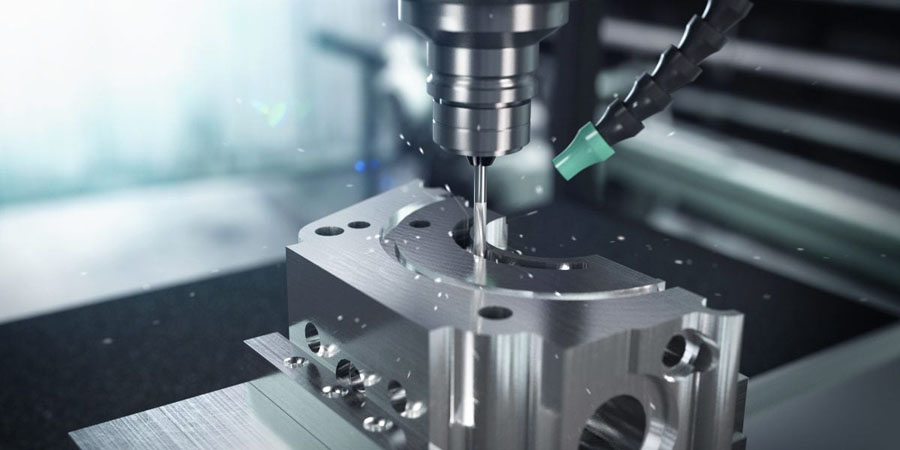The Internet of Things (IoT) has profoundly reshaped industries worldwide, experts predict global revenue from the IoT market to reach $1.5 trillion by 2029. CNC machining manufacturing is no exception. By integrating IoT technologies with CNC operations, manufacturers can achieve unprecedented levels of efficiency, precision, and flexibility. As competition tightens and demand for higher-quality, faster production grows, IoT-enabled CNC machining is quickly becoming a cornerstone of the future smart factory.
Incorporating IoT can significantly improve CNC machining processes. Here, we explore IoT’s impact on CNC machining, how IoT is revolutionizing CNC machining, its key applications, benefits, challenges, and what the future holds.
Understanding IoT in CNC Machining
IoT in CNC machining refers to the use of interconnected sensors, devices, and software platforms that collect, exchange, and analyze real-time data throughout the machining process. These systems allow machines to communicate with each other and with centralized control hubs, enabling automated decision-making, predictive maintenance, real-time monitoring, and production optimization.
Manufacturers use collected data to predict when machines need maintenance and optimize processes, thereby reducing waste, improving efficiency, and productivity.
IoT sensors can monitor the temperature, vibration, and tool wear of CNC machine tools. The Internet of Things in CNC manufacturing covers all aspects from small machine monitoring to higher-level machine to machine communication, thereby improving automation and reducing manual intervention.
In simple terms, IoT transforms traditional CNC machines from isolated, manually operated units into intelligent, networked systems that can self-optimize and self-correct with minimal human intervention.
Key Applications of IoT in CNC Machining
1. Real-Time Machine Monitoring
IoT sensors continuously collect data on critical machine parameters such as spindle speed, temperature, vibration, and tool wear. This real-time monitoring allows operators and supervisors to track performance metrics instantly, detect anomalies, and intervene before minor issues escalate into costly breakdowns.
2. Predictive Maintenance
Traditional preventive maintenance schedules are often based on rough time estimates. With IoT, maintenance becomes predictive. By analyzing data patterns, the system can forecast when specific components are likely to fail, enabling maintenance teams to replace parts or perform repairs precisely when needed—thus reducing downtime and saving costs.
3. Remote Operation and Control
Thanks to IoT connectivity, CNC machines can be monitored and even controlled remotely. Supervisors can oversee operations from different locations, receive alerts, adjust parameters, and ensure that production continues smoothly—even when physical presence on the shop floor is not possible.
4. Production Analytics and Optimization
By aggregating data from multiple machines and production lines, manufacturers can gain valuable insights into bottlenecks, inefficiencies, and optimization opportunities. IoT platforms analyze factors like cycle times, idle times, and energy consumption, enabling data-driven decisions that enhance overall productivity.
5. Quality Assurance and Traceability
IoT systems track every stage of the machining process, recording detailed information about each part produced. This improves quality control and provides full traceability for critical industries like aerospace, automotive, and medical device manufacturing, where compliance and reliability are paramount.
Benefits of IoT in CNC Machining
1. Increased Efficiency
By automating monitoring and optimization tasks, IoT systems dramatically reduce machine downtime, optimize workflows, and boost output without compromising quality.
2. Enhanced Precision and Consistency
Real-time feedback ensures that machining parameters stay within specified tolerances, reducing variability and improving part consistency—even across high-volume production runs.
3. Cost Reduction
Predictive maintenance, improved resource utilization, and reduced scrap rates all contribute to significant cost savings over time.
4. Better Decision-Making
Access to detailed, real-time data empowers manufacturers to make faster, smarter decisions based on actual performance metrics rather than assumptions.
5. Improved Safety
The Internet of Things reduces the need for manual input, thereby lowering the risk of employee injury. The communication between machines supports a higher degree of automation and reduces manual intervention. For example, intelligent robots can replace cutting tools after a certain period of operation on CNC machines or when the machine detects tool passivation.

Challenges of Implementing IoT in CNC Machining
Despite its benefits, integrating IoT into CNC manufacturing is not without challenges:
High Initial Investment:
Setting up IoT systems involves purchasing sensors, connectivity solutions, and cloud infrastructure, which can be costly upfront.
Data Security:
As machines connect to external networks, cybersecurity risks increase. Protecting sensitive production data requires robust security measures.
Integration with Legacy Systems:
Many older CNC machines were not designed with IoT in mind. Retrofitting legacy equipment with sensors and communication modules can be complex and costly.
Skill Gap:
Implementing and managing IoT-enabled systems require new technical skills. Manufacturers must invest in workforce training and upskilling to ensure successful adoption.
Future Trends: Where IoT and CNC Machining Are Headed
The fusion of IoT with CNC machining is just beginning. Future developments are expected to include:
Edge Computing:
Processing data closer to the machine rather than relying solely on cloud computing will reduce latency and enable real-time responses.
AI Integration:
Artificial Intelligence will enhance IoT systems’ ability to predict outcomes, optimize parameters automatically, and self-correct errors without human input.
5G Connectivity:
Faster and more reliable wireless communication will allow for even more complex data exchanges and real-time control across geographically dispersed facilities.
Digital Twins:
IoT data will feed into digital twin models—virtual replicas of CNC machines or entire production lines—enabling predictive simulations, maintenance planning, and design optimizations in a risk-free environment.
Conclusion
IoT is revolutionizing CNC machining manufacturing by unlocking real-time insights, optimizing processes, and enabling smarter, faster decision-making. While challenges such as initial costs and cybersecurity concerns must be addressed, the benefits of integrating IoT far outweigh the hurdles. As technology continues to advance, the synergy between IoT and CNC machining will lead manufacturers toward unprecedented levels of precision, efficiency, and innovation—paving the way for the smart factories of the future.



